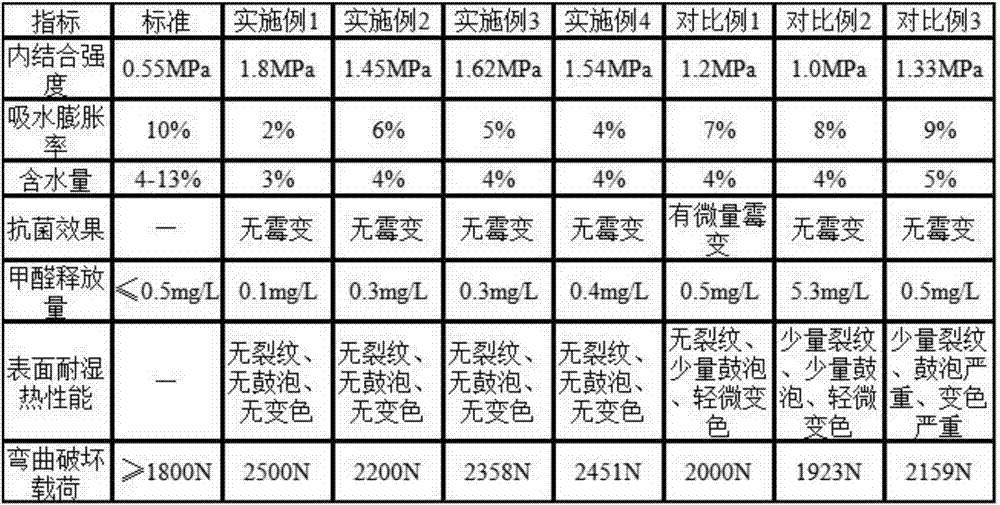Method for making artificial board with wood leftover materials and straw
A technology for wood scraps and wood-based panels, which is applied in the pretreatment of molding materials, manufacturing tools, raw material separation, etc., can solve the problems of high cost of treatment agents, influence on decorative performance, environmental hazards, etc., and achieve excellent antibacterial and mildew resistance. , Excellent anti-aging, anti-bacterial and anti-corrosion, and the effect of solving free formaldehyde pollution
- Summary
- Abstract
- Description
- Claims
- Application Information
AI Technical Summary
Problems solved by technology
Method used
Image
Examples
Embodiment 1
[0021] A method for making wood-based panels using wood scraps and straws, comprising the following steps: (1) pretreatment of miscellaneous wood and wood scraps: taking miscellaneous wood and wood scraps to be pulverized and sieved into cellulose particles with a particle size of 30 meshes, and the wood The cellulose particles were soaked and washed in urine oxygen solution (the molar mass ratio of urea to hydrogen peroxide was 3:5, and the weight ratio of wood fiber particles to urine oxygen solution was 1:10) at constant temperature for 30 minutes, soaking temperature was 45°C, and then added cellulose Degumming treatment with enzyme and pectinase and filtration, drying at 105°C for 4 hours, adding polylactic acid and vacuum drying at 45°C; (2) Pretreatment of crop straw: take the crop straw and put it into a mill for grinding, and then sieve After treatment, 30-mesh straw cellulose particles were obtained, which were degummed by adding cellulase and pectinase, filtered, and...
Embodiment 2
[0026] A method for making wood-based panels using wood scraps and straws, comprising the following steps: (1) pretreatment of miscellaneous wood and wood scraps: taking miscellaneous wood and wood scraps to be pulverized and sieved into cellulose particles with a particle size of 30 meshes, and the wood The cellulose particles were soaked and washed in urine oxygen solution (the molar mass ratio of urea to hydrogen peroxide was 2:5, the weight ratio of wood fiber particles to urine oxygen solution was 1:5) and soaked and washed for 30min at a constant temperature. Degumming treatment with enzyme and pectinase and filtering, drying at 90°C for 6 hours, adding polylactic acid and vacuum drying at 45°C; (2) Pretreatment of crop straw: take the crop straw and put it into a mill for grinding, and then sieve After treatment, 30-mesh straw cellulose particles were obtained, which were degummed by adding cellulase and pectinase, filtered, and dried at 120°C for 4 hours. The dried stra...
Embodiment 3
[0031] A method for making wood-based panels by using wood scraps and straws, comprising the following steps: (1) pretreatment of miscellaneous wood and wood scraps: taking miscellaneous wood and wood scraps to be crushed and sieved into cellulose particles with a particle size of 40 meshes, and the wood The cellulose particles were soaked and washed in urine oxygen solution (the molar mass ratio of urea to hydrogen peroxide was 3:4, and the weight ratio of wood fiber particles to urine oxygen solution was 1:15) for 50 minutes at constant temperature, the soaking temperature was 30°C, and then the fiber Sulfase and pectinase were degummed and filtered, dried at 120°C for 4 hours, added polylactic acid and dried in vacuum at 30°C; (2) Pretreatment of crop straw: take the crop straw and put it into a mill for powder treatment, after sieving After sub-treatment, 40 mesh straw cellulose particles were obtained, which were degummed by adding cellulase and pectinase, filtered, and dr...
PUM
| Property | Measurement | Unit |
|---|---|---|
| Particle size | aaaaa | aaaaa |
Abstract
Description
Claims
Application Information
 Login to View More
Login to View More - R&D
- Intellectual Property
- Life Sciences
- Materials
- Tech Scout
- Unparalleled Data Quality
- Higher Quality Content
- 60% Fewer Hallucinations
Browse by: Latest US Patents, China's latest patents, Technical Efficacy Thesaurus, Application Domain, Technology Topic, Popular Technical Reports.
© 2025 PatSnap. All rights reserved.Legal|Privacy policy|Modern Slavery Act Transparency Statement|Sitemap|About US| Contact US: help@patsnap.com

